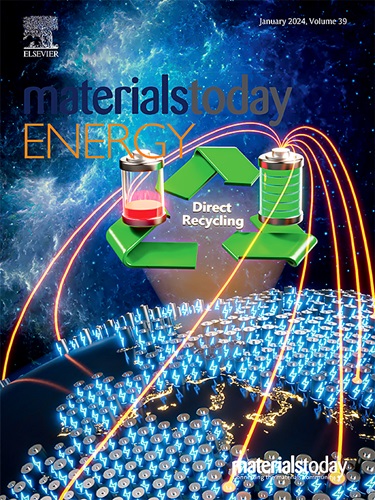Green-Solvent Processable Polymeric Hole Transport Materials with Functional Groups for Inverted Perovskite Solar Cell
IF 8.6
2区 材料科学
Q1 CHEMISTRY, PHYSICAL
引用次数: 0
Abstract
Exploring novel hole transporting materials (HTMs) with high hole mobility and eco-friendly processability are imperative for the commercialization of perovskite solar cells (PSCs). However, there is a “trade-off” that the introduction of large-conjugated units aiming to ensure high hole mobility, inevitably compromises the green-solvent solubility of HTMs. In this work, a hybrid strategy of rigidity and flexibility is proposed, in which the conjugated unit is assembled by the rigid binaphthylamine core, and the amide-bond constitutes the flexible backbone. Polar solubilizing units ethylenedioxythiophene and thiophene are used as bridges to construct two kinds of polymers, cited as EDOT-SMe and T-SMe, respectively. Both polymers achieve high hole mobility, well-matched energy levels and efficient defect passivation effect toward the perovskite films. When processing the HTM films with the green solvent (2-methylanisole), the corresponding PSCs deliver fill factors as high as 82.7% for EDOT-SMe and 81.9% for T-SMe, respectively. Consequently, s of 20.25% for EDOT-SMe and 20.09% for T-SMe are realized, outperforming that of commercial polymer poly[bis(4-phenyl)(2,4,6-trimethylphenyl)amine] (PTAA, 19.71%). Moreover, PSCs with these polyamides achieve good long-term stability. This work paves a new path for exploring efficient and green-solvent processable polymeric HTMs.用于反相包晶石太阳能电池的含功能基团的绿色溶剂可加工聚合物空穴传输材料
要实现过氧化物太阳能电池(PSC)的商业化,就必须探索具有高空穴迁移率和环保加工性能的新型空穴传输材料(HTMs)。然而,为了确保高空穴迁移率而引入大型共轭单元不可避免地会影响 HTMs 的绿色溶剂溶解性,这是一个 "权衡 "问题。本研究提出了一种刚柔相济的混合策略,即共轭单元由刚性的二萘胺核心组装而成,而酰胺键则构成柔性骨架。极性增溶单元乙二氧基噻吩和噻吩被用作桥来构建两种聚合物,分别称为 EDOT-SMe 和 T-SMe。这两种聚合物都能实现高空穴迁移率、良好的能级匹配以及对包晶石薄膜的高效缺陷钝化效应。当使用绿色溶剂(2-甲基苯甲醚)处理 HTM 薄膜时,相应的 PSC 的填充因子分别高达 EDOT-SMe 的 82.7% 和 T-SMe 的 81.9%。因此,EDOT-SMe 的填充因子为 20.25%,T-SMe 为 20.09%,优于商用聚合物聚[双(4-苯基)(2,4,6-三甲基苯基)胺](PTAA,19.71%)。此外,含有这些聚酰胺的 PSC 具有良好的长期稳定性。这项工作为探索高效、可在绿色溶剂中加工的聚合物 HTM 铺平了新的道路。
本文章由计算机程序翻译,如有差异,请以英文原文为准。
求助全文
约1分钟内获得全文
求助全文
来源期刊

Materials Today Energy
Materials Science-Materials Science (miscellaneous)
CiteScore
15.10
自引率
7.50%
发文量
291
审稿时长
15 days
期刊介绍:
Materials Today Energy is a multi-disciplinary, rapid-publication journal focused on all aspects of materials for energy.
Materials Today Energy provides a forum for the discussion of high quality research that is helping define the inclusive, growing field of energy materials.
Part of the Materials Today family, Materials Today Energy offers authors rigorous peer review, rapid decisions, and high visibility. The editors welcome comprehensive articles, short communications and reviews on both theoretical and experimental work in relation to energy harvesting, conversion, storage and distribution, on topics including but not limited to:
-Solar energy conversion
-Hydrogen generation
-Photocatalysis
-Thermoelectric materials and devices
-Materials for nuclear energy applications
-Materials for Energy Storage
-Environment protection
-Sustainable and green materials
 求助内容:
求助内容: 应助结果提醒方式:
应助结果提醒方式:


